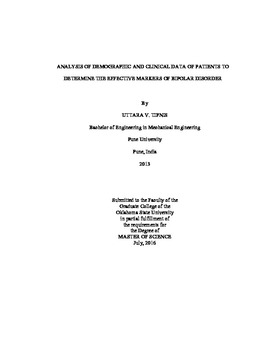| dc.contributor.advisor | Heragu, Sunderesh | |
| dc.contributor.author | Tipnis, Uttara Vinay | |
| dc.date.accessioned | 2017-02-22T22:16:37Z | |
| dc.date.available | 2017-02-22T22:16:37Z | |
| dc.date.issued | 2016-07-01 | |
| dc.identifier.uri | https://hdl.handle.net/11244/49169 | |
| dc.description.abstract | Bipolar disorder is also known as manic depression. Patients with this disease exhibit symptoms of depression and mania or hypomania in a cyclical manner. While depression symptoms are relatively easy to detect, manic and hypomanic symptoms are not. As a result, patients with bipolar disorder are either misdiagnosed as suffering from just depression or are diagnosed late � typically five to ten years from the onset of the disorder. The mood of a bipolar patient misdiagnosed as having depression and treated only for that condition can become elevated to a state of hypermania (Matza et al., 2005 and Charney et al., 2003). A late diagnosis can worsen the bipolar condition as well. Thus, a misdiagnosis or late diagnosis could aggravate the symptoms, and may require the bipolar patient to be hospitalized. This situation is made worse by the presence of psychological and/or physiological comorbidities that commonly coexist in patients with bipolar disorder.In this thesis, we apply logistic regression models, decision trees, and artificial neural networks to detect the existence of bipolar disorder in a patient with that disease at an early stage by analyzing their clinical and sociodemographic data, including comorbidities and prescribed medication. The goal is to apply the aforementioned three techniques to detect the existence of bipolarity in a patient with reasonable accuracy, so that he or she may be presented to psychiatrists for further medical diagnosis and treatment. The techniques will also help in screening out the patients needing treatment for other psychiatric disorders, e.g., major depression, that have symptoms similar to bipolar disorder. We use clinical and demographic data from Cerner Health Facts� database and the techniques identify the variables that can help detect bipolarity. We compare the three techniques relative to their effectiveness in detecting bipolar patients for the dataset used in this thesis. Based on the Cerner database, our study also finds that some of the variables identified in the literature as effective predictors of bipolar disorder are not as effective or do not have the same relationship with bipolar disorder. | |
| dc.format | application/pdf | |
| dc.language | en_US | |
| dc.rights | Copyright is held by the author who has granted the Oklahoma State University Library the non-exclusive right to share this material in its institutional repository. Contact Digital Library Services at lib-dls@okstate.edu or 405-744-9161 for the permission policy on the use, reproduction or distribution of this material. | |
| dc.title | Analysis of Demographic and Clinical Data of Patients to Determine the Effective Markers of Bipolar Disorder | |
| dc.contributor.committeeMember | Delen, Dursun | |
| dc.contributor.committeeMember | Kamath, Manjunath | |
| osu.filename | Tipnis_okstate_0664M_14838.pdf | |
| osu.accesstype | Open Access | |
| dc.description.department | Industrial Engineering & Management | |
| dc.type.genre | Thesis | |
| dc.type.material | text | |
